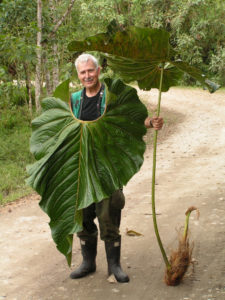Spotlight on Lucid keys supporting plant taxonomy at Missouri Botanical Garden
While most Lucid identification keys aim to provide public access to taxonomic and diagnostic expertise (via online and mobile apps), there are situations where Lucid keys can be used to support the taxonomic process itself. This spotlight article illustrates how Lucid is being used by Dr Tom Croat at the Missouri Botanical Garden, St Louis, USA to support the taxonomic work of his team, as well as providing an online identification aid.

Tom Croat with the 100,000th collection Anthurium centimillissimum photo by Dan Levin.
For many years, Tom’s taxonomic work has focussed on the philodendron or aroid family (Araceae). The genera of this family are often large and morphologically challenging, particularly the genus Anthurium, possibly the world’s largest genus with over 3,000 species. As Tom puts it - “Araceae is a family with still thousands of undescribed species: the only way one can deal with such large groups is to use Lucid. Without Lucid, I could not deal with it, since there are now 1650 species in Lucid keys for Anthurium. We also have Lucid Keys for Adelonema, Dieffenbachia, Dracontium, Philodendron and Stenospermation. Current work is on constructing a key for Spathiphyllum”.
Over the years, Tom has collected more than 109,000 herbarium collections, more than 10,000 living plants, and maintains the world's largest and most comprehensive collection of living aroid plants in the Garden's greenhouses.
Lucid matrix keys are initially used as a means of “cataloguing” new species that are introduced to the collection. The major taxonomic features of the living plants, as well as of dried herbarium specimens, are described in detail. The characters (more than 100 in all) are recorded into the existing Lucid Matrix, and new feature/states are added as necessary, together with their respective scores.
With the recent availability of the new dichotomous (pathway) key construction option, that has recently been upgraded and incorporated in the Lucid Builder software, Tom thinks there may be new opportunities here. “Having a Lucid dichotomous key would allow us to prepare keys to separate species in many groups that remain poorly known. While the Lucid matrix key enables us to select species that have already been incorporated into the key, a dichotomous key allows one to decide where a given species needs to be placed that is not already in the key.
Moreover, published revisions are expected to have dichotomous keys that are an integral part of the revision, so a Lucid Key, workable as it might be, will not serve that purpose. Thus, it is important that the Lucid Program should provide a means whereby a dichotomous key can be constructed from the existing taxonomic data stored within it. There are a number of large genera in Araceae, where we have 250 or more species. A dichotomous key allows one to visualize where new elements should fit and then one can decide if it should be fully described and entered into the Lucid matrix key”.
Tom has been in touch with us regarding further ideas he has on how both Lucid matrix and dichotomous keys might be adapted to help in this taxonomic process, which we are looking into. For further information about Tom’s work go to a recent publication - Araceae, a Family with Great Potential February 2019 Annals of the Missouri Botanical Garden 104(1):3-9
|